Related Research Articles
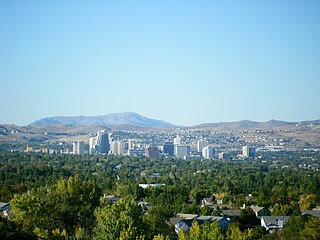
Reno is a city in the northwest section of the U.S. state of Nevada, along the Nevada-California border, about 22 miles (35 km) from Lake Tahoe, known as "The Biggest Little City in the World". Known for its casino and tourism industry, Reno is the county seat and largest city of Washoe County and sits in the High Sierra foothills, in the Truckee River valley, at the eastern side of the Sierra Nevada. The Reno metro area occupies a valley colloquially known as the Truckee Meadows, which because of large-scale investments from Greater Seattle and San Francisco Bay Area companies such as Amazon, Tesla, Panasonic, Microsoft, Apple, and Google has become a new major technology center in the United States.

Virginia City is a census-designated place (CDP) that is the county seat of Storey County, Nevada, and the largest community in the county. The city is a part of the Reno–Sparks Metropolitan Statistical Area.

The Comstock Lode is a lode of silver ore located under the eastern slope of Mount Davidson, a peak in the Virginia Range in Virginia City, Nevada, which was the first major discovery of silver ore in the United States and named after American miner Henry Comstock.
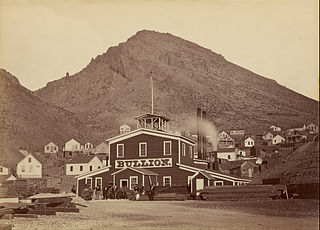
The Virginia Range is a mountain range of western Nevada, primarily within Storey County, and extending east into Lyon County. The range is named after James Finney, "Old Virginny", an early discoverer of gold associated with the Comstock Lode.

The Virginia and Truckee Railroad is a privately owned historical heritage railroad, headquartered in Virginia City, Nevada. Its private and publicly owned route is 14 miles long. The railroad owns and uses the service mark "Queen of the Short Lines". The V&T Railroad runs up to seven trains per day, many in steam behind locomotive #29, a 2-8-0 Consolidation, or an ex-US Army GE 80-ton diesel from Virginia City, from Memorial Day until the end of October each year.
Frederic Joseph DeLongchamps was an American architect. He was one of Nevada's most prolific architects, yet is notable for entering the architectural profession with no extensive formal training. He has also been known as Frederick J. DeLongchamps, and was described by the latter name in an extensive review of the historic importance of his works which led to many of them being listed on the U.S. National Register of Historic Places in the 1980s.

Carson City is a 1952 American Western Warnercolor film directed by Andre DeToth and starring Randolph Scott, Lucille Norman, and Raymond Massey.

Mound House is a small unincorporated community in Lyon County, Nevada on U.S. Route 50 that is situated between Nevada's capital, Carson City, and Dayton. Its elevation is 4,974 feet (1,516 m). It is in Lyon County, one of eight Nevada counties that allow for legalized prostitution, and is home to four brothels.

Silver City is a near ghost town and a small residential community in Lyon County, Nevada, USA, near the Lyon/Carson border. The population as of the 2000 census was 170.

Gold Hill is an unincorporated community in Storey County, Nevada, located just south and downhill of Virginia City. Incorporated December 17, 1862, in order to prevent its annexation by its larger neighbor, the town at one point was home to at least 8,000 residents. Prosperity was sustained for a period of 20 years between 1868 and 1888 by mining the Comstock Lode, a major deposit of gold and silver ore. Mines such as the Yellow Jacket, Crown Point, and Belcher brought in over $10 million each in dividends. Historical remnants of the town can still be seen, including the Gold Hill Hotel, promoted as Nevada's oldest hotel, in existence since 1861; the former Bank of California building; the restored Virginia & Truckee Railroad depot; the Depression-Era Crown Point Mill; and remains of several of the mines and residences in various states of restoration and repair.
State Route 341 is a state highway in western Nevada connecting US 50 near Dayton to Reno via Virginia City. Commonly known as the Virginia City Highway, or Geiger Grade north of Virginia City, the route has origins dating back to the 1860s.
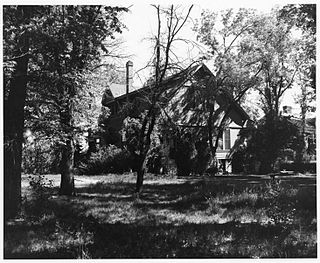
The Francis G. Newlands Home is a historic house at 7 Elm Court in Reno, Nevada, United States. Built in 1890, it is the former mansion of United States Senator Francis G. Newlands (1846-1917), a driving force in passage of the 1902 Newlands Reclamation Act. It was declared a National Historic Landmark in 1963 and listed on the National Register of Historic Places in 1966. The house is privately owned and is not open to the public.

Reno station is an Amtrak intercity train station in Reno, Nevada, served by the California Zephyr train. It is also served by Amtrak Thruway Motorcoach routes to Sacramento.

The Virginia and Truckee 18 Dayton is a historic standard gauge steam locomotive on display in Carson City, Nevada. It spent its working life on the Virginia and Truckee Railroad.

AbrahamVan Santvoord Curry is considered the founding father of Carson City, Nevada. A native of the state of New York, he traveled to the West Coast during the California Gold Rush and settled in Nevada's Eagle Valley, where Carson City was established.
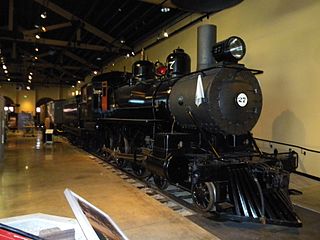
Virginia and Truckee Railroad Engine No. 27 is an historic standard gauge steam locomotive. It was on display at the Nevada State Railroad Museum in Carson City, Nevada, but was traded with The Dayton and is currently on display at the Comstock Historical Center in Virginia City. It was the last locomotive acquired new by the Virginia and Truckee Railroad, and pulled the last commercial train for the V&T on May 31, 1950, the date that freight and passenger services officially terminated for the company. The locomotive was placed on the National Register of Historic Places due to its association with the Virginia and Truckee Railroad and transportation development in Nevada.

Virginia and Truckee Railroad No. 22, also known as the "Inyo", is a 4-4-0 "American" type steam locomotive that was built by the Baldwin Locomotive Works in 1875 and pulled both passenger and freight trains. The Inyo weighs 68,000 lb (31,000 kg). Its 57 in (140 cm) driving wheels deliver 11,920 lb (5,410 kg) of tractive force. In 1877 it was fitted with air brakes and in 1910 it was converted to burn oil rather than wood.

The Minden Flour Milling Company is a historic flour mill located at 1609 U.S. Highway 395 in Minden, Nevada. Built in 1906, the mill was the largest of five flour mills built in the Carson Valley and is the only one still in existence. The building has a transitional design in two respects, as it reflects the change from early European-influenced mills to 20th-century American mills as well as the move from smaller rural mills to large mills built along railroads. The mill features a masonry bearing-wall style of construction, a concrete foundation considered novel at the time, and well-crafted masonry and woodwork. The operators of the mill had a significant influence on Minden commerce, as they were instrumental in both the extension of the Virginia and Truckee Railroad to the town and the expansion of electric power to the area. By the 1920s, the mill had become "one of the biggest milling concerns in the state"; it could process 100 barrels of flour a day and also produced chicken and cattle feed. The mill operated until the 1960s.
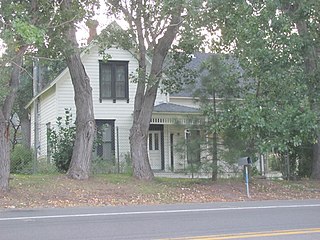
Nevada State Historic Preservation Office PDF documents
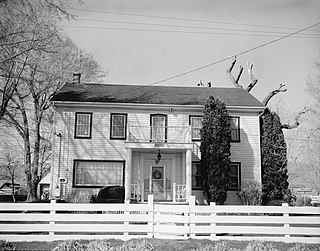
The Peleg Brown Ranch, at 12945 Old Virginia Rd. in Reno, Nevada, dates from 1864. Also known as the Louis Damonte Ranch, it includes Bungalow/craftsman and Greek Revival architecture. It was listed on the National Register of Historic Places in 1994; the listing included five contributing buildings on about 4 acres (1.6 ha).
References
- 1 2 "National Register Information System". National Register of Historic Places . National Park Service. July 9, 2010.
- 1 2 Rebecca R. Ossa (February 18, 1998). "National Register of Historic Places Registration: Virginia & Truckee Railroad Depot - Carson City, Nevada". National Park Service. and accompanying photos
- ↑ "National Register of Historic Places in Carson City". www.noehill.com. Retrieved 8 July 2016.